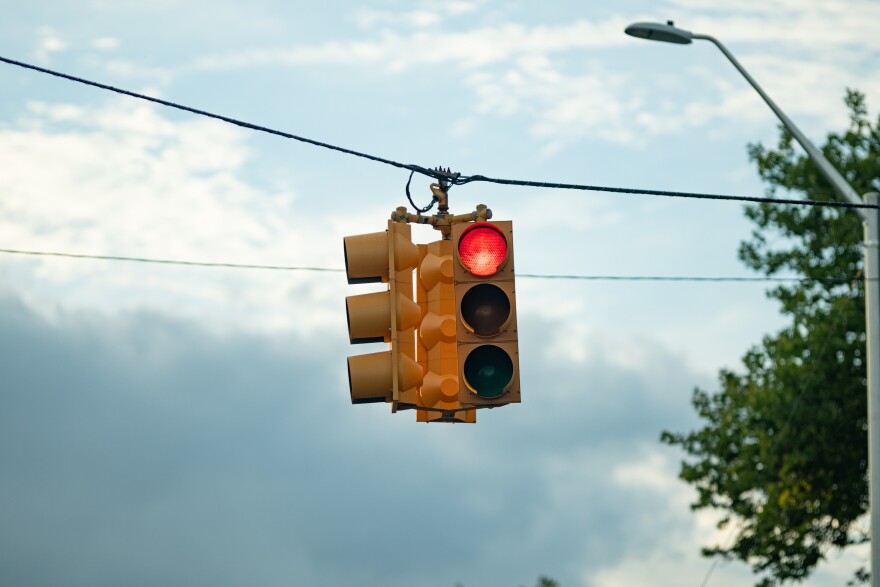Recent storms in the Piedmont Triad have caused fallen trees, flooding and power outages — sometimes wiping out traffic lights and signals.
That’s what happened in Bill Herndon’s Davidson County neighborhood. As he watched drivers sail through the unlit intersections recklessly, he had this thought:
“We spend hundreds of thousands of dollars putting up a stoplight," Herndon said. "Why the heck can we not spend an extra few hundred dollars and have a backup power supply in that light?”
For this edition of Carolina Curious, WFDD’s Amy Diaz turned to the North Carolina Department of Transportation to find the answer.
Nick Zinser is an engineer with NCDOT’s Signal Design Section. He focuses on the western region of the state and explained a little bit about what exactly he does.
“We’re responsible for all the standards, you know what signals, how they're going to operate, what they're going to look like," Zinser said. "Investigate new technologies that are out there, deal with traffic issues as they come up, and ensure that everyone has safe and efficient signals across the state.”
As far as backup batteries, Zinser said that’s not something North Carolina has right now. The department is investigating how it could incorporate these in the future though.
But it’s not a simple process, especially when there are more than 10,000 signals, including traffic lights, in the state.
“We have to establish how long we'd want a system to last, you know," Zinser said. "And that kind of dictates the size of the system and the cost of the system, how much maintenance it will take to keep up with that system.”
He notes they’d also need to decide whether they want a battery that runs for a few hours or a few days. Those choices impact installation and cost.
But Zinser said even the battery systems that last a few hours aren’t cheap. His estimate is tens of thousands of dollars — per traffic signal.
“So it goes back to that scale of things. You know, we want to make changes and do things, but we have to figure out where they're going to go, and who's gonna get that first, and who's going to get the next one and how we're going to pay for that," Zinser said. "Because these projects get very expensive.”
When I pressed him for a time frame, he said we might start to see some battery backups implemented in the next five to ten years, but it’ll ultimately come down to having the funding. The good news is that it might be less expensive by then.
“Battery technology grows very quickly with all the EV vehicles and all the devices that use batteries, so, you know, I think it's something that will become cheaper as time goes on," Zinser said. "And that'll be beneficial for us to get into it when it's a little bit more mature.”
And Zinser said he wants the department to continue pursuing it and find a way to get battery backup systems out there.
Before I let Zinser go, I asked him one more question from our listener. Herndon also wanted to know why traffic signals here in the state don’t do a better job of responding to the flow of traffic.
According to Zinser, we do have what he says are traffic-responsive signals.
“We have what we call loops in the pavement, and they are a wire that's cut into the pavement, and that's how we detect vehicles," he said. "We send power to these loops, and it creates an inductive field over the loop. And then when a car goes across it, we can detect that there's a metal object there, and that's how they actuate that loop.”
So when someone pulls up to a turn lane, Zinser said the loop senses that they’re there and tells the traffic signal to give them a green arrow.
He added that these loops are extremely common throughout the state. But there are limitations to what they can do. For example, loops in a 45-mile-per-hour zone are about 300 feet out from the light. So they can only detect traffic from so far away.
Another challenge, he said, is that North Carolina is a rapidly growing state. So when a new Walmart or apartment complex goes up, the traffic in that area suddenly changes.
There are some areas that have more advanced traffic-detecting technology, like radar and video cameras, but they’re more expensive.
“I can see that being something that is more and more common as we keep upgrading our signals and modernize things," Zinser said.
When new signals are installed, it can take some time to gather traffic data and optimize the light’s timing. So it’s normal if it’s not perfect right away. But if a resident feels like the traffic signals in their area could use improvement, NCDOT wants to know.
“Notify us that we need this change, or if the timing isn't great, or something," Zinser said. "You know, we certainly would appreciate the feedback, and that can help us go in and direct our efforts.”
I guess you could say you have the “green light” to give feedback. You can do that at NCDOT’s website, or contact the office for your division directly.

